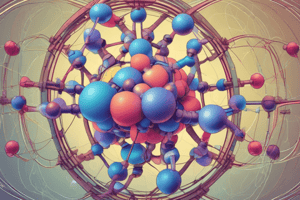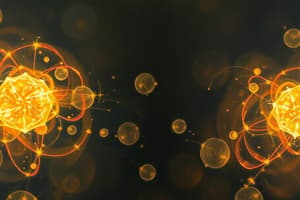Podcast
Questions and Answers
What is the term used for the temperature at which a solid transforms into a liquid?
What is the term used for the temperature at which a solid transforms into a liquid?
- Vaporization Point
- Boiling Point
- Melting Point (correct)
- Freezing Point
Freezing occurs when energy is added to the liquid particles.
Freezing occurs when energy is added to the liquid particles.
False (B)
What process occurs when a liquid turns into gas?
What process occurs when a liquid turns into gas?
Vaporization
The energy required to change a substance from solid to liquid at its melting point is known as the ______.
The energy required to change a substance from solid to liquid at its melting point is known as the ______.
Match the state of matter with its characteristic:
Match the state of matter with its characteristic:
Which of the following statements about boiling is correct?
Which of the following statements about boiling is correct?
Which statement best describes gas particles?
Which statement best describes gas particles?
The process of condensation is the reverse of vaporization.
The process of condensation is the reverse of vaporization.
Liquids can be compressed like gases.
Liquids can be compressed like gases.
What is the term for the temperature at which the vapor pressure of a liquid equals the external pressure?
What is the term for the temperature at which the vapor pressure of a liquid equals the external pressure?
What is the primary difference between crystalline and amorphous solids?
What is the primary difference between crystalline and amorphous solids?
In solids, particles have _______ kinetic energy compared to particles in gases.
In solids, particles have _______ kinetic energy compared to particles in gases.
Match the states of matter with their characteristics:
Match the states of matter with their characteristics:
What causes the pressure of a gas in a container?
What causes the pressure of a gas in a container?
The thermal energy in particles is the sum of their kinetic and potential energy.
The thermal energy in particles is the sum of their kinetic and potential energy.
Describe how thermal energy affects the state of matter.
Describe how thermal energy affects the state of matter.
Flashcards
Melting Point
Melting Point
The temperature at which a solid changes to a liquid.
Heat of Fusion
Heat of Fusion
The energy needed to turn a solid into a liquid at its melting point.
Vaporization
Vaporization
Process where a liquid becomes a gas. Particles gain enough kinetic energy to overcome attractions.
Boiling Point
Boiling Point
Signup and view all the flashcards
Heat of Vaporization
Heat of Vaporization
Signup and view all the flashcards
Sublimation
Sublimation
Signup and view all the flashcards
Heating Curve
Heating Curve
Signup and view all the flashcards
Plasma
Plasma
Signup and view all the flashcards
Kinetic Theory of Gases
Kinetic Theory of Gases
Signup and view all the flashcards
Gas Pressure
Gas Pressure
Signup and view all the flashcards
Liquid State
Liquid State
Signup and view all the flashcards
Solid State
Solid State
Signup and view all the flashcards
Crystalline Solid
Crystalline Solid
Signup and view all the flashcards
Amorphous Solid
Amorphous Solid
Signup and view all the flashcards
Thermal Energy
Thermal Energy
Signup and view all the flashcards
Melting
Melting
Signup and view all the flashcards
Study Notes
Matter and Thermal Energy
- Matter exists in different states: solid, liquid, gas, and plasma.
- Each state has unique properties related to the arrangement and movement of its particles.
Gas State
- Kinetic theory explains gas behavior.
- Gas particles are widely separated with lots of empty space.
- Gas particles are in constant random motion.
- Collisions between gas particles are elastic.
- Gas pressure is caused by collisions between gas particles and the container's walls.
Liquid State
- Liquid particles are constantly moving but less quickly than gas particles.
- Liquid particles have less kinetic energy than gas particles.
- Liquid particles are more tightly packed than gas particles, but less so than solid particles.
- Liquids cannot be compressed.
- Liquids take the shape of their container.
Solid State
- Solids have a definite shape and volume.
- Solid particles are closely packed together.
- Solid particles vibrate, but do not have much kinetic energy.
- Solids cannot be compressed or change shape easily.
Crystalline and Amorphous
- Crystalline solids have particles arranged in regular geometric patterns.
- Crystalline solids have a definite melting point.
- Examples include salt, sugar, and sand.
- Amorphous solids do not have a regular geometric pattern.
- Amorphous solids have no definite melting point.
- They soften gradually before becoming liquid.
Thermal Energy in Particles
- Thermal energy is the total energy of the particles in a material.
- Thermal energy includes kinetic and potential energy of the particles.
- Temperature is the average kinetic energy of the particles in a substance.
- In solids, strong attractions between particles hold them in place.
- Solids have a definite shape and volume.
Changes in State
- Adding thermal energy to a system causes some particles to move faster.
- Energy is transferred between particles during changes of state.
- Melting occurs when kinetic energy overcomes attractive forces, breaking the crystalline structure.
- Melting point is the temperature at which a solid becomes a liquid.
- Heat of fusion is the energy needed to change a substance from solid to liquid at its melting point.
- Freezing is the opposite of melting, energy is removed and solid forms.
- Freezing point is the temperature at which a liquid becomes a solid.
Vaporization and Condensation
- Vaporization is the process of a liquid becoming a gas.
- Particles must move fast enough to overcome the attractions between them.
- Evaporation occurs at the surface of a liquid.
- Boiling occurs throughout the liquid at a specific temperature.
- Condensation is the process of a gas becoming a liquid.
- Boiling point is the temperature at which the vapor pressure of a liquid equals the external pressure.
- Heat of vaporization is the energy required to change a substance from liquid to gas.
Sublimation
- Solids can directly change into gases (or vice-versa) under certain pressures: this is sublimation
- Dry ice (solid carbon dioxide) sublimates.
Heating Curves
- Heating curves show how temperature changes over time as thermal energy is added.
- At melting/boiling points, thermal energy is used to overcome the attractive forces causing temperature to remain constant.
Plasma State
- Plasma is a state of matter where matter has enough energy to overcome the attractions between particles and within atoms.
- Atoms in plasma collide with great force,
- Examples include lightning, stars, and fluorescent lights.
- Plasma is the most common state of matter in the universe.
Fact About Plasma State
- Plasma is an ionized gas.
- Electrons are ionized and move independently of the atoms.
- Much of the mass of the universe is in plasma state.
Thermal Expansion
- Temperature increase causes particles to move faster and further apart, expanding volumes of substances.
- Temperature drop causes substances to contract.
- Thermometers use thermal expansion of liquids to measure temperature.
Hot Air Balloons
- Thermal expansion of air increases volume without changing mass.
- This results in decreased density, making hot air balloons rise.
Water as an Exception
- Water expands when freezing, unlike other substances.
- This is due to the unique structure of water molecules that align unevenly making empty spaces when frozen.
- Water's exceptional behavior is crucial for life on Earth.
Solid or Liquid?
- Amorphous solids soften and melt over a range of temperatures.
- Liquid crystals flow during melting without losing their ordered arrangement.
Studying That Suits You
Use AI to generate personalized quizzes and flashcards to suit your learning preferences.




